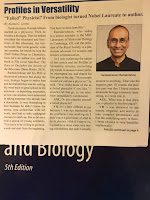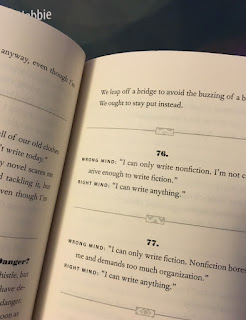 |
| Failed physicist? |
Many readers of Intermediate Physics for Medicine and Biology may be in a similar position of having been trained in physics but now learning biology. Ramakrishnan provides an interesting case study in how to make such a transition. I looked up his biographical statement on the Nobel Prize website, and I reproduce excerpts below. Changing fields is not easy, but it is possible, and can ultimately lead to groundbreaking research.
In the APS News article, Ramakrishnan said something that could be the motto for IPMB.Choosing Basic Science
[When Ramakrishna was growing up in India, he was looking for a university for his undergraduate studies.] A faculty member in the physics department in [the University of] Baroda, S.K. Shah, told me about a brand new curriculum they were introducing for their undergraduate course. It began with the Berkeley Physics Course, and was supplemented by the Feynman Lectures on Physics before moving on to more specialized areas. I therefore decided to enroll in the B.Sc. course in physics in Baroda, my hometown. Since I was only 16 when I began this course, I sensed that my parents, especially my father, were relieved that I was not leaving home….
I found myself tremendously interested by the articles in biology in Scientific American, to which I have subscribed off and on through the years. It appeared that hardly a month went by without a major breakthrough in the life sciences, whereas physics was having a hard time making any fundamental progress. Certainly I felt that if I continued in physics, I would be doing boring and tedious calculations rather than making really interesting advances. The result was that I felt so frustrated that I withdrew from my thesis work and spent an inordinate amount of time on extracurricular activities….
[Ramakrishna eventually finished his BS in physics, and then obtained a PhD in Physics at Ohio University]…. By that time I had already decided I was going to switch to biology.
Transition to Biology
Since I hardly knew any biology, I felt I needed formal training of some sort. I could go to graduate school again, with the option of getting a second Ph.D. or go to medical school, which was ironic since I had turned down the opportunity to do precisely that when I was younger. I took the MCAT …. but despite scoring in the 99th percentile in all the subjects, I only got one interview (at Yale) because I was not a U.S. citizen or even a permanent resident at that point…. However, I had also written to a number of graduate programs. Many of them said that they would not accept someone who already had a Ph.D. The chairman of the Molecular Biophysics and Biochemistry ... department at Yale, Franklin Hutchinson, wrote to me saying that while they could not take me as a graduate student, he would circulate my CV to faculty members for a potential postdoctoral position. Two of them responded: One was Don Engelman, and the other, ironically, was Tom Steitz, with whom I shared the Nobel Prize. Although I found their work very interesting, I thought doing a postdoc directly from a degree in physics would leave me with too narrow a background in biology to be an effective scientist. So when three schools accepted me into their graduate program, I chose to go to the University of California, San Diego (UCSD)…. During the first year, I did several lab rotations in biology and took as many undergraduate courses as I could possibly manage, including genetics, taught by Dan Lindsley, a well-known Drosophila geneticist, and biochemistry, where I was inspired by the brilliant and enthusiastic lectures of Paul Price.
In my second year [at UCSD], I settled down to do research in Mauricio Montal's lab. Mauricio had developed an ingenious method of incorporating conducting channels into lipid bilayers formed by bringing together two defined monolayers, and was thus doing single molecule biophysics at a time when nobody called it that. Around this time, however, I read an article in Scientific American by Don Engelman and Peter Moore about their ribosome work, and became interested in it. It also struck me that there was no longer any reason to continue on to obtain a second Ph.D. because I felt I had acquired the background I needed. I therefore wrote to Don Engelman, one of the two people from Yale who had responded to me earlier. Don was interested in membrane proteins, a subject I was already working on in Mauricio's lab. Don wrote back and said that he and Peter had a position open on their ribosome project, and I could always work on membrane-related projects once I got there. Peter arranged to meet me in San Diego in early 1978 and offered me a postdoctoral position soon afterwards. Thus began my lifelong interest in ribosomes….
Physics is a great training for every science because it teaches you quantitative and mathematical thinking, and that way of approaching problems is becoming increasingly important in every field, including biology.Want to learn more? Ramakrishna has a new book out: Gene Machine: The Race to Dicipher the Secrets of the Ribosome. It's on my list of books to read. Below are a couple videos in which you can hear from Ramakrishna himself. Enjoy!









